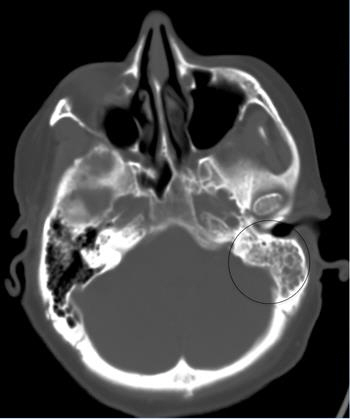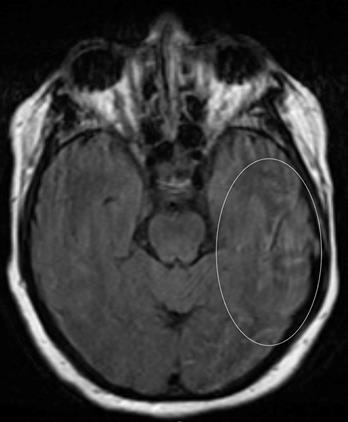J Neurocrit Care.
2021 Jun;14(1):57-60. 10.18700/jnc.210003.
Pneumococcal meningitis complicated by otomastoiditis and pneumocephalus confounding an acute ischemic stroke diagnosis
- Affiliations
-
- 1Department of Anesthesiology, The University of Kansas School of Medicine, Wichita, KS, USA
- KMID: 2517134
- DOI: http://doi.org/10.18700/jnc.210003
Abstract
- Background
Approximately one-fourth of admissions to stroke centers are diagnosed with non-stroke conditions or stroke mimics. Differentiating between these diagnoses and acute ischemic stroke is an important and time-sensitive task. The decision whether or not to administer thrombolytic therapy is also a critical component, and its safety has been studied numerous times.
Case Report
This case presents a patient with pneumococcal meningitis initially diagnosed as an acute ischemic stroke treated with thrombolytic therapy prior to further imaging.
Conclusion
Many stroke mimics such as migraines, infections, and seizures exist. Time is of the essence for the treatment of an acute ischemic stroke. The safety profile of tissue plasminogen activator has been studied numerous times in stroke mimics and shown to be relatively safe indicating if the patient has no contraindications for stroke intervention, treatment of stroke should not be extensively delayed to rule out stroke confounders.
Keyword
Figure
Reference
-
1. Powers WJ, Rabinstein AA, Ackerson T, Adeoye OM, Bambakidis NC, Becker K, et al. 2018 Guidelines for the Early Management of Patients With Acute Ischemic Stroke: a guideline for healthcare professionals from the American Heart Association/American Stroke Association. Stroke. 2018; 49:e46–110.
Article2. Fonarow GC, Zhao X, Smith EE, Saver JL, Reeves MJ, Bhatt DL, et al. Door-to-needle times for tissue plasminogen activator administration and clinical outcomes in acute ischemic stroke before and after a quality improvement initiative. JAMA. 2014; 311:1632–40.
Article3. O'Carroll CB, Rubin MN, Chong BW. What is the role for intra-arterial therapy in acute stroke intervention? Neurohospitalist. 2015; 5:122–32.4. Dawson A, Cloud GC, Pereira AC, Moynihan BJ. Stroke mimic diagnoses presenting to a hyperacute stroke unit. Clin Med (Lond). 2016; 16:423–6.
Article5. Durand ML, Calderwood SB, Weber DJ, Miller SI, Southwick FS, Caviness VS Jr, et al. Acute bacterial meningitis in adults: a review of 493 episodes. N Engl J Med. 1993; 328:21–8.6. Weisfelt M, van de Beek D, Spanjaard L, Reitsma JB, de Gans J. Clinical features, complications, and outcome in adults with pneumococcal meningitis: a prospective case series. Lancet Neurol. 2006; 5:123–9.
Article7. Van der Poel NA, van Spronsen E, Dietz de Loos DA, Ebbens FA. Early signs and symptoms of intracranial complications of otitis media in pediatric and adult patients: a different presentation? Int J Pediatr Otorhinolaryngol. 2017; 102:56–60.
Article8. Pantangi P, Cherian SV. Pneumocephalus; a rare presentation of streptococcal meningitis. Intern Med. 2011; 50:2249–50.
Article9. Damergis JA, Chee K, Amitai A. Otogenic pneumococcal meningitis with pneumocephalus. J Emerg Med. 2010; 39:e109–12.
Article10. Cuinat L, Nasr N, Kamsu JM, Tanchoux F, Bonneville F, Larrue V. Meningeal disease masquerading as transient ischemic attack. J Stroke Cerebrovasc Dis. 2014; 23:1738–43.
Article11. Fernandes PM, Whiteley WN, Hart SR, Al-Shahi Salman R. Strokes: mimics and chameleons. Pract Neurol. 2013; 13:21–8.
Article12. Moulin S, Leys D. Stroke mimics and chameleons. Curr Opin Neurol. 2019; 32:54–9.
Article13. Moore MJ, Stuart J, Humphreys A, Pfaff JA. To tPA or not to tPA: two medical-legal misadventures of diagnosing a cerebrovascular accident as a stroke mimic. Clin Pract Cases Emerg Med. 2019; 3:194–8.
Article14. Chernyshev OY, Martin-Schild S, Albright KC, Barreto A, Misra V, Acosta I, et al. Safety of tPA in stroke mimics and neuroimaging-negative cerebral ischemia. Neurology. 2010; 74:1340–5.
Article15. Ali-Ahmed F, Federspiel JJ, Liang L, Xu H, Sevilis T, Hernandez AF, et al. Intravenous tissue plasminogen activator in stroke mimics. Circ Cardiovasc Qual Outcomes. 2019; 12:e005609.
Article
- Full Text Links
- Actions
-
Cited
- CITED
-
- Close
- Share
- Similar articles
-
- A Case of Localized Spontaneous Pneumocephalus Caused by Pneumococcal Meningitis
- Spontaneous Pneumocephalus Caused by Pneumococcal Meningitis
- Development of Spinal Epidural Abscess during Treatment of Pneumococcal Meningitis
- A case of pneumococcal endocarditis complicated by meningitis
- Pneumoncoccal Meningitis Presenting with Ventriculitis and Pneumocephalus



